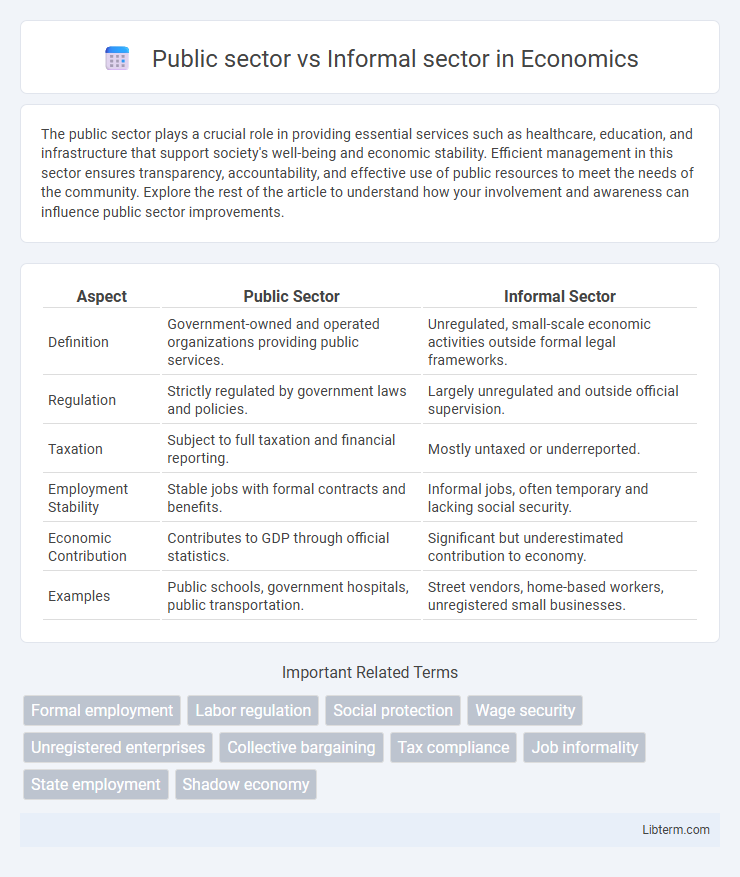The public sector plays a crucial role in providing essential services such as healthcare, education, and infrastructure that support society's well-being and economic stability. Efficient management in this sector ensures transparency, accountability, and effective use of public resources to meet the needs of the community. Explore the rest of the article to understand how your involvement and awareness can influence public sector improvements.
Table of Comparison
| Aspect | Public Sector | Informal Sector |
|---|---|---|
| Definition | Government-owned and operated organizations providing public services. | Unregulated, small-scale economic activities outside formal legal frameworks. |
| Regulation | Strictly regulated by government laws and policies. | Largely unregulated and outside official supervision. |
| Taxation | Subject to full taxation and financial reporting. | Mostly untaxed or underreported. |
| Employment Stability | Stable jobs with formal contracts and benefits. | Informal jobs, often temporary and lacking social security. |
| Economic Contribution | Contributes to GDP through official statistics. | Significant but underestimated contribution to economy. |
| Examples | Public schools, government hospitals, public transportation. | Street vendors, home-based workers, unregistered small businesses. |
Overview of the Public Sector
The public sector encompasses government-owned institutions and agencies responsible for delivering essential services such as healthcare, education, infrastructure, and law enforcement. It operates under strict regulatory frameworks with funding primarily derived from taxation and public budgets. Unlike the informal sector, which is characterized by unregulated and often temporary economic activities, the public sector ensures compliance, accountability, and standardized service provision to the community.
Understanding the Informal Sector
The informal sector comprises unregistered, small-scale economic activities that operate without formal contracts or government regulation, often providing employment to a significant portion of the labor force in developing economies. Unlike the public sector, which consists of government-controlled organizations implementing official policies and regulations, the informal sector thrives on flexibility, low entry barriers, and lack of social protection. Understanding the informal sector is crucial for policymakers to devise inclusive economic strategies that address labor rights, taxation, and social security gaps while promoting sustainable development.
Key Differences Between Public and Informal Sectors
The public sector consists of government-operated organizations funded by taxpayers, providing regulated services such as education, healthcare, and infrastructure with formal employment contracts and legal protections. In contrast, the informal sector includes small-scale, unregulated economic activities like street vending or home-based work, lacking formal contracts, social security benefits, and consistent tax contributions. While the public sector emphasizes stability, accountability, and standardized wages, the informal sector is characterized by flexibility, limited oversight, and vulnerability to economic fluctuations.
Employment Opportunities and Job Security
The public sector offers stable employment opportunities with formal contracts, benefits, and regulatory protections that ensure job security. In contrast, the informal sector provides flexible and accessible employment but often lacks legal protections, social security, and consistent income stability. Workers in the public sector generally enjoy greater long-term job security, while informal sector employment tends to be precarious and vulnerable to economic fluctuations.
Wage Structure and Income Stability
The public sector typically offers a structured wage system with fixed salaries, regular increments, and benefits that ensure greater income stability for employees. In contrast, the informal sector often relies on irregular, performance-based earnings with minimal social security, resulting in fluctuating and uncertain income. Wage disparities between these sectors highlight the challenge of economic security for informal workers lacking formal contracts and protections.
Contribution to Economic Growth
The public sector drives economic growth through large-scale infrastructure projects, public services, and regulatory frameworks that create stable environments for investment. The informal sector contributes significantly by providing flexible employment and fostering entrepreneurial activities, especially in developing economies where it accounts for up to 60% of GDP and employment. Both sectors complement each other by balancing formal institutional support with grassroots economic participation, enhancing overall economic resilience and expansion.
Regulatory Framework and Compliance
The public sector operates under a comprehensive regulatory framework with strict compliance requirements enforced by government authorities, ensuring transparency, accountability, and standardized procedures. In contrast, the informal sector often functions outside formal regulations, resulting in minimal oversight, limited enforcement of legal standards, and challenges in tax collection and labor protections. This disparity creates a regulatory gap that affects economic stability, workers' rights, and equitable market competition.
Social Protection and Employee Benefits
The public sector typically provides comprehensive social protection and employee benefits, including health insurance, pensions, and unemployment benefits, ensuring job security and financial stability for workers. In contrast, the informal sector often lacks formal social protection mechanisms, resulting in limited access to healthcare, retirement plans, and worker compensation, which increases vulnerability to economic shocks. Efforts to extend social protection to informal workers focus on inclusive policies, such as social insurance schemes and targeted subsidies, to improve coverage and reduce inequality.
Challenges Facing Both Sectors
Public sector faces challenges such as bureaucratic inefficiencies, limited budget allocations, and rigid regulatory frameworks that hinder innovation and responsiveness. Informal sector struggles with lack of legal recognition, inadequate access to finance, and vulnerability to exploitation due to absence of social protection. Both sectors experience difficulties in ensuring sustainable growth, workforce development, and compliance with labor standards.
Future Trends and Policy Recommendations
The future landscape of the public sector is expected to emphasize digital transformation, enhanced transparency, and sustainable development, driven by advancements in technology and increasing public demand for accountability. Conversely, the informal sector will continue to play a critical role in emerging economies by providing flexible employment opportunities but requires formalization strategies, social protection measures, and regulatory frameworks to improve labor conditions and economic inclusion. Policy recommendations include integrating digital tools for service delivery in public institutions, promoting inclusive financial access, incentivizing formalization through simplified registration processes, and fostering public-private partnerships to bridge gaps between formal and informal economies.
Public sector Infographic

 libterm.com
libterm.com